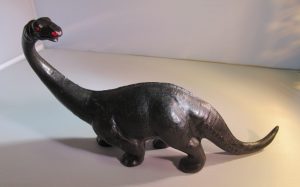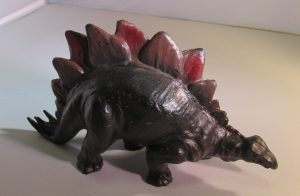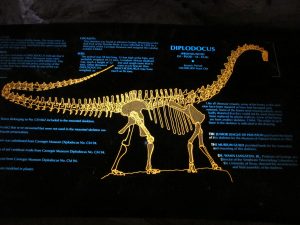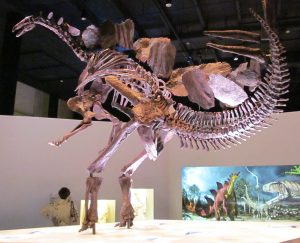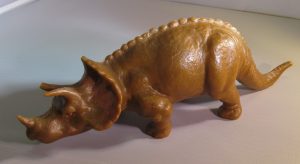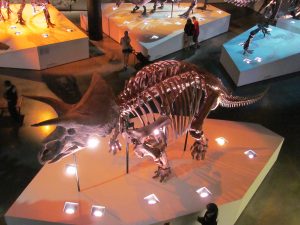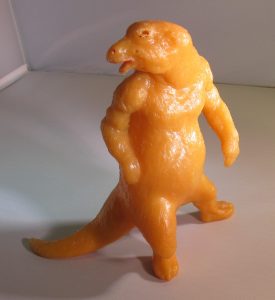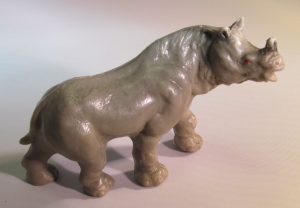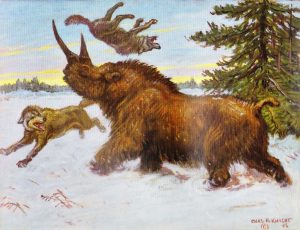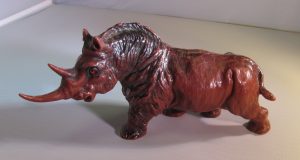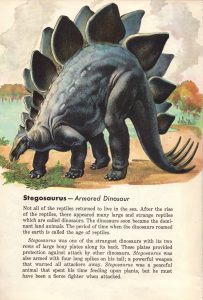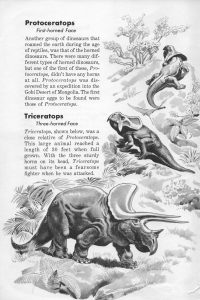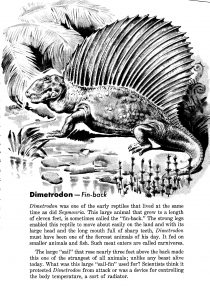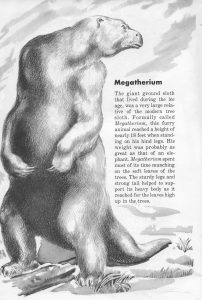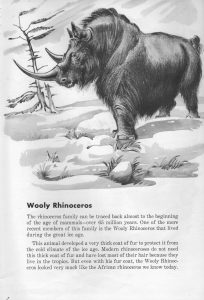In the mid-1950s I collected some “waxy” plastic dinosaur and (so-called) prehistoric mammal toys. They were what was considered in the day as the most realistic interpretations of those animals available anywhere for kids to play with and learn from. They were based on the latest interpretive efforts of some famous scientists that were employed by the most influential natural history museums. The toys cost me (or my parents) 25 to 50 cents each. Recently I saw some of these exact toys for sale on EBAY for up to $500 each! Seeing such a high value drove me to pull my collection out of the kids’ toy closet in our hallway and to display them on a shelf in my library. In this article I will take a look back at how these toys came to be, and how some current interpretive hypotheses vary from those of the mid-20th century.
I remember that in the 1970s, although no longer in production, these toys were still considered as pretty good interpretations of the animals they represented. At that time my wife was an elementary school teacher, and she borrowed my toys on occasion to help teach her students about dinosaurs and evolution. Yes, I really was an evolutionist back then! The kids were told to treat the toys very carefully because they did not fare well if smashed together in mock combat.
 J.D.’s Collection of nine Miller “waxy” Plastic Toys in 2022
J.D.’s Collection of nine Miller “waxy” Plastic Toys in 2022
The Miller brand of toys were based primarily on artwork by Rudolph F. Zallinger that was on display in giant murals at Yale University’s Peabody Museum. One mural was called, “The Age of Reptiles” and a second was called, “The Age of Mammals.” Both murals were conceived and completed based on the current evolutionary story in vogue at the time of painting. These paintings were also featured in a very popular 3-volume book series, The World We live In, that was published by Life Magazine in the 1950s.
The toys are called “waxy” because the manufacturing process developed by the E.H. Miller Company produced plastic toys that had a surface that was quite smooth but was also waxy feeling. While most of the toys were indeed based on Zallinger’s work, I think some were based on the work of another popular natural history artist of the time by the name of Charles Knight.
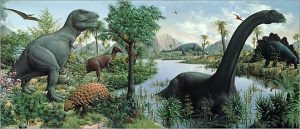 Portion of Zallinger’s Mural Showing Tyrannosaurus, Brontosaurus, and Stegosaurus
Portion of Zallinger’s Mural Showing Tyrannosaurus, Brontosaurus, and Stegosaurus
Miller Tyrannosaurus
Miller Brontosaurus
Miller Stegosaurus
In the mid-1950s the experts thought that dinosaurs were sluggish reptiles that moved with their tails dragging behind them. That opinion has today been replaced with dinosaur depictions that show them very active with the ability to balance their tails with the forward portion of their bodies. Some current paleontologists like to represent Tyrannosaurus, Brontosaurus and even Stegosaurus with great mobility as seen in the three images below.
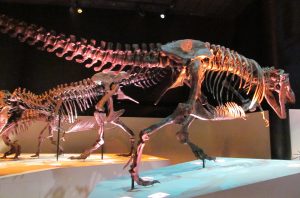 Tyrannosaurus Museum Skeletal Reconstruction
Tyrannosaurus Museum Skeletal Reconstruction
Sauropod Museum Skeletal Drawing
Stegosaurus Museum Skeletal Reconstruction
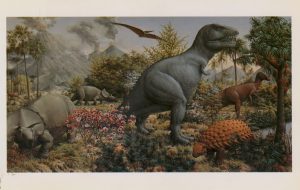 Portion of Zallinger’s Mural with Triceratops at the left
Portion of Zallinger’s Mural with Triceratops at the left
For the Horn-Faced kind of dinosaurs, the 1950s and current ideas for reconstruction have not changed very much. The Triceratops, Styracosaurus, Chasmosaurus, etc. dinosaurs are still thought to resemble an army tank.
Miller Triceratops
Modern Triceratops Museum Skeletal Reconstruction
I don’t think that Zallinger’s depiction of the Dimetrodon reptile was what was used by Miller to make his waxy toy. I think it is more likely that Miller used the Charles Knight rendition instead. What do you think?
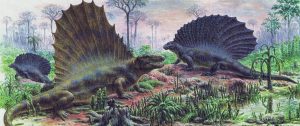 Dimetrodon according to Zallinger.
Dimetrodon according to Zallinger.
 Dimetrodon according to Knight
Dimetrodon according to Knight
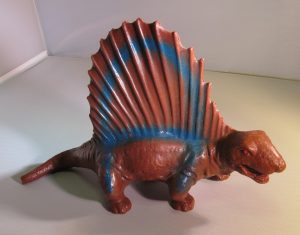 Miller waxy toy Dimetrodon (with broken tail end)
Miller waxy toy Dimetrodon (with broken tail end)
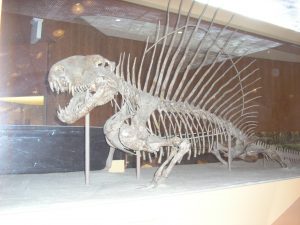 Dimetrodon Skeletal Reconstruction at Smithsonian
Dimetrodon Skeletal Reconstruction at Smithsonian
The Age of Mammals
As each decade goes by more and more evidence is uncovered or reinterpreted that indicates that the old story of mammals slowly overcoming the dominance of dinosaurs over millions of years was pure fiction. The biblical creationist explanation that reptiles and mammals have always coexisted is easy to support these days. But in the 1950s the experts were sure the Darwinian ideas were true, and so they believed they could explain life with a slow change of one-animal-kind-into-another-kind model by depicting the “evolution” in artistic drawings in their storybooks and murals. In the Zallinger murals the macroevolution of life always moved from left to right.
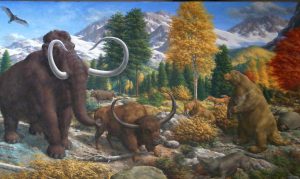 Woolley Mammoth, Bison, and Megatherium in Zallinger Mural
Woolley Mammoth, Bison, and Megatherium in Zallinger Mural
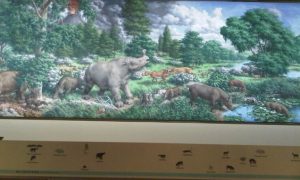 Additional Age of Mammals depictions including Subhyracodon in Zallinger Mural
Additional Age of Mammals depictions including Subhyracodon in Zallinger Mural
Miller Megatherium
Miller Subhyracodon
Charles Knight Painting of Woolly Rhino
Miller Woolly Rhinoceros
Childrens’ Books from the 1950s
American Museum of Natural History adventurer Roy Chapman Andrews, and associated paleontologists like John H. Ostrom and Edwin H. Colbert held sway in the 1950s and 60s. By that I mean they greatly determined what the general public understood dinosaurs and certain fossil-determined mammals to have looked like. This can be seen in the book A Child’s Book of Prehistoric Animals by Bruno Frost that was published in 1956. I think my Aunt Verna gave me this book about the same time that I was collecting the waxy figures. I also obtained the books by R.C. Andrews, All About Dinosaurs and All About Strange Beast of the Past, as well as Colbert’s first book on dinosaurs in the 1950s. You should be able to see the specific similarities between the Zallinger and Knight representations, the waxy figures, and the drawings from the 1956 book that follow.
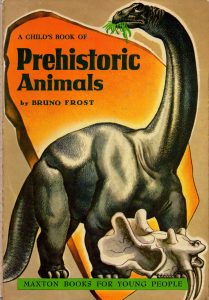 Brontosaurus depiction on Frost’s book cover
Brontosaurus depiction on Frost’s book cover
Stegosaurus depiction in Frost’s book
Frost’s Protoceratops & Triceratops
Frost’s Dimetrodon
Frost’s Megatherium
Frost’s Woolly Rhinoceros
All of these animals were great examples of God’ majestic engineering ability. They are all now thought to be extinct, some due to the conditions in or surrounding the global Flood, others probably due to other ecological situations. The Bible tells us that they were all created by God according to kinds, a fact that precludes the idea that of the many kinds found extant or extinct that any one kind evolved into any other kind over time.
Glory be to God!
J.D. Mitchell

